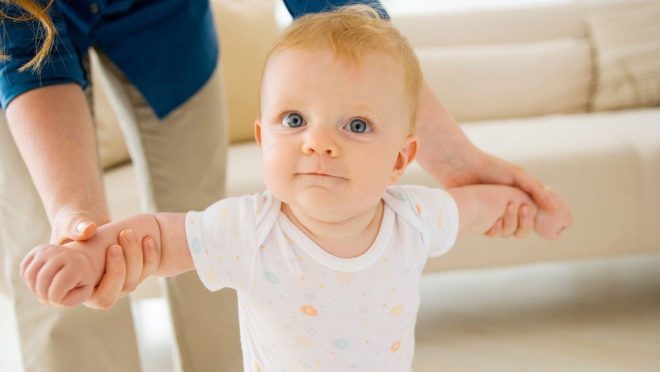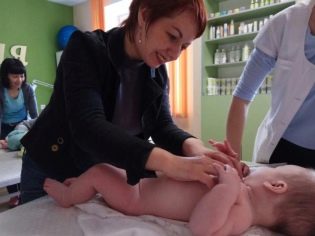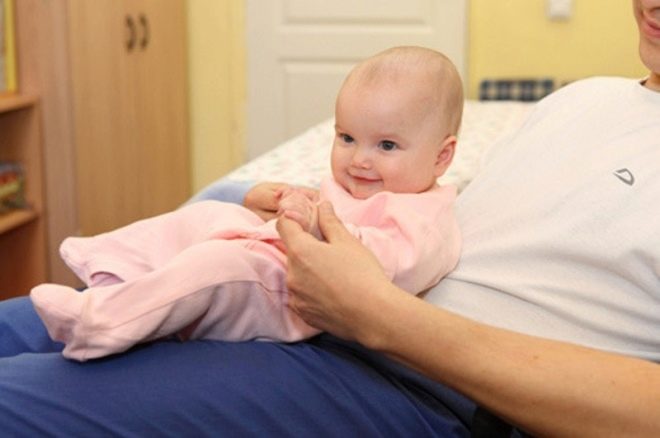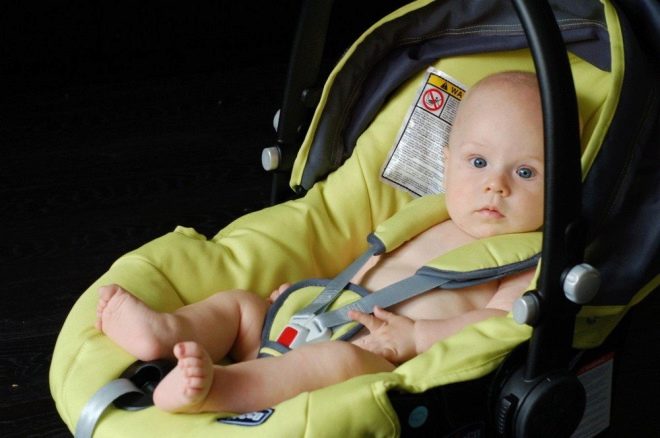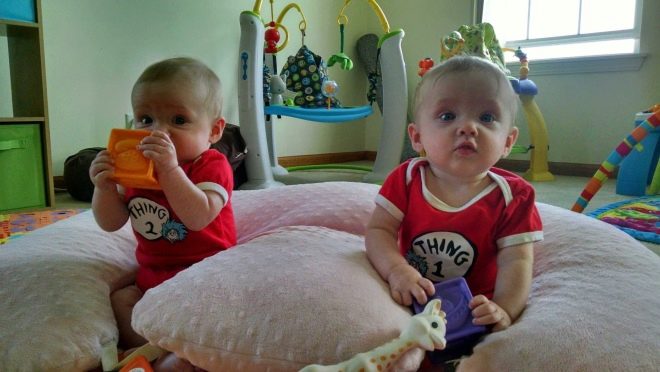At what age can you start to sit down a child?
The development of physical skills in infants is one of the most acute for parents, especially concerned about the timeliness of the appearance of a particular skill. Very often, mothers of infants begin to sound the alarm due to the fact that their baby does not sit at the age of half a year, while the neighbor child already quite tolerably copes with this. Is it worth it to worry and from what age you can begin to sit down small children, we will tell in this material.
When and how does the baby start to sit?
The question of when a child should begin to sit independently, sounds somewhat incorrect, because all the children are different, and therefore the developmental periods of each baby are very individual. However, the average statistical standards exist, but they should be treated solely as exemplary landmarks, and not as the ultimate truth.
It is believed that a healthy baby should start to sit at the age of six months, by 7 months he should master the seat with support, and without one, the child should sit freely at the age of 9-10 months.
Confident sitting is usually preceded by a long preparatory stage, which begins with the neonatal period. To sit down, the baby needs to have well-developed muscles in the neck, back, arms, and abdomen. They will help the spine to withstand the new type of load in the form of the baby's own weight in a sitting position. In addition, the child still needs to learn how to keep balance.
If you notice that the baby has learned to roll over and does it quite often and actively, then you can be calm - he will soon be seated. Sit down kids start differently. But for all, the first stage is short-term, that is, the child assumes a sitting position on the priest, but cannot hold the load, therefore, he collapses onto his back or side.
About a month after the beginning of the first attempts, the child learns to sit with support, and after another month and a half and without it. At about 8 months, a child can spend a rather long time sitting, playing, some even try to get on all fours and start crawling.
It can be very difficult for parents to be on standby, and all the time they try to interfere with natural processes and help the child to sit down faster.
Hurry up the crumb is not necessary, he develops a consonant own program, intervention in which can harm his physical development and health.
Impact factors
If nature dictates its own conditions, then why are these conditions different for different children: one child starts to sit on her own only after 9 months, and another tries to sit down at five? It is a matter of influence factors that leave their mark on the speed of mastering new skills.
Let's look at them in more detail.
- Health status. Babies who appeared on time, having no history of birth injuries, hypoxia, ischemia, hip dysplasia and congenital diseases, sit traditionally earlier. Weakened and often ill children in physical development may lag behind their stronger peers. Neurological disorders, even minor ones, also reduce the speed of learning new skills. The strongest of these factors is prematurity.This does not mean that weakened or premature babies are lagging behind in development, they just need a little more time to adapt to the outside world and to develop their musculoskeletal system.
- The weight of the child. Chubby kids look sweetly, but the extra weight has not helped anyone yet easier to withstand physical exertion. This also applies to babies. Babies with normal weight and thin kids (full-term) usually sit down and begin to crawl before their plump peers.
- Temperament. Own character traits in a fetus appear even during pregnancy, and after birth one can easily determine who is who. Phlegmatic and melancholy-minded children sit down later because of some laziness and slowness peculiar to them. But choleric and sanguine tend to move more and in the end to learn new skills earlier.
- Environment and motivation. This factor is the only one that depends on the parents, and that partly. Thus, a child who is given freedom, without restricting it constantly with a playpen or outside of a crib, begins to sit earlier. If the baby does not have an acute need and desire to sit down, he will not rush. But because parents are quite capable of creating such a motivation, for example, by hanging the toy so that it can only be reached in a sitting position.
- Heredity also influences. If mom and dad were “late” children in their childhood, then it is at least wrong to count on Stakhanov’s advancement of all imaginable and inconceivable terms by their own children.
About sexual characteristics
It is believed that girls develop earlier, that they are less lazy and quickly learn new movements. At the same time, it is believed that boys can be seated earlier, since girls have a reproductive system in such a way that sitting up to 7 months can lead to subsequent sterility in adulthood. Both statements are not true.
Bone and muscular systems, as well as articular and cartilage tissues develop regardless of the person’s gender. And the question of the slowness of the boys is quite controversial. Medicine has no evidence that girls develop faster. In the period preceding puberty, and during puberty, there really is a difference, but it is caused by different sex hormones. Children of the first year of life develop the same.
Sit down and boys and girls, it is not recommended up to six months. Many pediatricians generally do not recommend dropping children off until they sit on their own.
If the pussy does it early - in 5 months, for example, it is not necessary to prevent the child. But also to force the child to sit, if he cannot, it is impossible.
About sitting down
Speaking of sitting down, you need to clearly understand what it is. People mistakenly call sitting down and planting children between pillows, and verticalization on the hands of my mother.
Correctly called sitting down relative verticalization, in which the spine of the child is not located at a right angle to the pelvis. In other words, to hold the baby upright in his arms, holding his back to him, is an option of sitting properly. Putting the child in the stroller and raising the bottom of the stroller about 45 degrees is also true.
But both are recommended not to be done before the child himself begins to show a desire to sit, that is, at the preparatory stage of mastering the skill (on average, from 4-6 months).
It is easy to understand that the baby is “ripe” for sitting down: the toddler starts spinning and puffing while lying in a bed or stroller, trying to rise on his elbows. Mom should remember that while the child is not ready to sit, you need to keep it upright with mandatory support under your ass.
If they put a baby on their knees, an adult should not sit up straight, but recline. And then the load on the spine will be significantly reduced.
Unfortunately, mothers do not often fall into the nuances of word formation, and the concept of "sit down" means the forced verticalization of the child, landing. Doctors do not recommend this at all. The immature spine, joints, and muscles are disproportionately burdened for them. Consequences may include poor posture, scoliosis, dislocations, subluxations and fractures of the hip joints, pelvic bones injuries (especially dangerous for reproductive function and the general health of girls), limb deformity, incorrect placement of the feet in the future, the occurrence of vertebral compression changes, and intervertebral hernia.
Therefore, you can sit down in the sense of “planting a child” not earlier than he learns to sit.
Prohibited actions
To protect the child, many doctors, including the famous doctor Yevgeny Komarovsky, recommend parents to leave the child alone. He will sit down when he himself is ready for this, when he can.
If you wish, you can do gymnastics, including in it exercises for the development of the back, neck, arms and abdomen. Massages and walks, bathing and hardening, lack of compulsion in eating are useful.
Those who recommend sitting down the child, despite his willingness, should be sent to the clinic for experiments, even if it is a certified doctor, your local pediatrician, - says Dr. Komarovsky.
Parents should know that Starting verticalization with the use of jumpers or walkers is very dangerous. These devices force the child to be in a position that cannot be considered natural for his age, and therefore the vertical load will be very significant. No matter how bright and attractive the jumpers in the children's store, remember that they are not just harmful, they are potentially dangerous to the health of your child.
If the child began to sit down at the stage of short-term sitting, he should be protected from blows when falling. It will be necessary for the baby to fall, and therefore it is necessary to impose pillows or ottomans on it, as well as to be constantly nearby to exclude abnormal situations, such as mechanical asphyxia, which can happen if a fallen baby gets stuck between the pillows.
What should pay attention
- The pose of the child when trying to sit down can be any. Some babies lean on the palm, others on two hands, others on the elbows, and fourth sit down only after they adopt the pose on all fours. Do not try to correct the childish way of achieving the goal - he does it the way he likes.
- When the child began to sit, pay attention to his posture. A round back with the shoulders lowered indicates that the baby has weak neck and back muscles. If the baby falls back, you need to begin to strengthen the abdominal muscles, abs. If it falls to the side, it is necessary to strengthen the abdominal muscles and oblique lateral muscles. To help parents come complexes exercises for each individual muscle group. Do not allow the child to sit on their knees with eversion out. W-shaped fit injures hip joints.
- If a child at 9 months does not even observe attempts to sit on his own, be sure to show him to a neurologist, orthopedist and pediatrician.
For information on how old you can sit down a child, see the following video.



